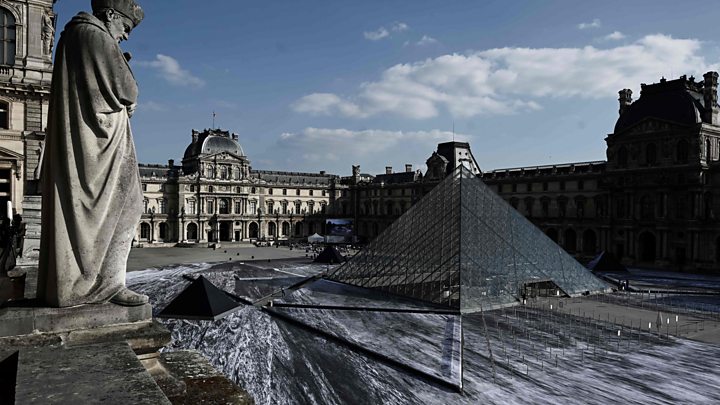Image copyright
Reuters
Christ Mocked is one of three surviving panels from a Cimabue work dating back to around 1280
The discovery of a 13th Century Cimabue painting above an elderly woman’s hotplate in northern France stunned the art world and now the government has decided it is a national treasure.
France has barred the export of Christ Mocked for 30 months to allow time to raise funds to buy it for the nation.
Found in September, it was sold at auction the following month for €24m (£20m; $27m).
Cimabue, also known as Cenni di Pepo, was a pivotal pre-Renaissance artist.
How Christ Mocked was found
The tiny work, just 20.3cm by 28.5cm in size, was spotted by an auctioneer during a visit to an elderly woman’s house near the town of Compiègne, 90km (56 miles) north of Paris.
The woman was in her nineties and had moved to a retirement home, so an inventory was being made before her house was due to be emptied.
Image copyright
AFP/Getty Images
The painting fetched an astonishing €24m at auction weeks after it was found hanging above a hotplate in northern France
Auctioneer Philomène Wolf spotted the work hanging above a hotplate in an open kitchen, on a wall leading to the living room. The owners had apparently assumed it was a Russian icon whose colours had faded over the years.
The house had already been sold. “I had a week to sort out the contents and empty it,” Ms Wolf told French media. “I had to make space in my diary, otherwise it would all have gone to the recycling.”
Evaluated by experts in Paris, it was identified as a Cimabue and then put up for auction. Although the buyer was not confirmed, French reports say the work was bought by two Chilean collectors specialising in Italian Renaissance art who live in the US.
Why Cimabue’s painting is important
He was among the first Italian painters to move away from the more formal Byzantine style of art to a more realistic treatment of people. It is easy to see why Christ Mocked was mistaken for a religious icon as his work was produced on poplar wood panels with backgrounds of gold paint.
Largely known as a fresco painter in Florence and Rome, he signalled the start of the Florentine Renaissance and is thought to have been master to Giotto, the great Florentine artist of the 14th Century.
His Christ Mocked is one of three panels that have survived from his work known as the Diptych of Devotion, painted around 1280. The other two panels are in New York and London’s National Gallery.
The French culture ministry said in a statement that Christ Mocked was in good condition and revealed more than the other two panels how Cimabue used a new language of expression, especially “visible in the humanistic treatment of the face of Jesus, the rendition of people’s expressions or space”.
It said that Culture Minister Franck Riester had followed the recommendation of France’s commission for national treasures to block the painting’s export abroad to allow funds to be raised with the aim of enabling the work to be exhibited in the Louvre in Paris alongside another Cimabue work, the Maestà de Santa Trinita.
You might also like:

Media playback is unsupported on your device
